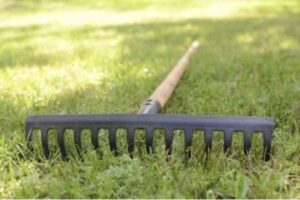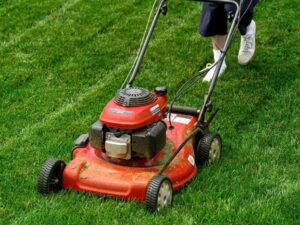I can’t stress enough, the importance of first impressions. So, today I discuss the number one area most homeowners fail to hit the mark, the front lawn.
A nicely manicured lawn is essential in setting the stage for a positive experience for prospective buyers, and it takes much less work than you’d think. Here are some tips to get you started.

How and When to Dethatch Your Lawn
I’ll start with the most labour-intensive of the tips. Dethatching your lawn only needs to be done every 2 to 3 years, so suck it up and get raking. Detaching is the process of removing dead grass and above-ground roots from the surface of your lawn. Doing this allows nutrients and moisture to better penetrate the soil reaching the roots of healthy grass. You can use a sturdy metal rake or rent/purchase an electric dethatcher. Dethatching should do this at the beginning of the season. However, hold off until the ground has thawed and dried; doing it when the lawn is sopping wet will result in pulling up healthy grass.

When to Fertilize
For most of you, using a hand spreader will be sufficient. However, if you have a large lawn, a push spreader may be preferred. The two most important applications are Spring and Fall. Purchase fertilizers designed specifically for these seasons provide different nutrients to promote healthy grass at that time of year. In addition to a healthy application in the Spring and Fall, spread out one or two more applications during the summer months.

How Often to Water Grass
The grass is extremely resilient and can handle a couple of months without much water; however, new grass or extreme drought requires more frequent watering. The best time of day to water is in the early hours, between 5 AM and 9 AM. There is typically less wind at this time and no harsh sunlight or high temperatures, resulting in more water penetrating the soil before blowing or evaporating away. Watering in the evening or overnight may result in too much water sitting, causing mildew. Don’t be concerned if there are extreme droughts as your lawn will bounce back when temperatures cool and water is introduced again; however, dry and brown lawns aren’t very resilient to high traffic. If your kids are running around on the lawn during these times, I’d suggest watering to maintain it.

How Long to Cut Grass
Keeping your grass long promotes thick growth. Cut frequently, trying not to cut off no more than ½ – 1 inch at a time and keep it at a length of not less than 3½ inches.

Maintain Grass by Pulling Weeds
While this is often the area that people think they struggle with the most, focussing on steps 1 – 4 will result in a thick lawn that hinders the growth of weeds. Weeds thrive in open, airy spaces. When your grass is thick and blocking out the sunlight, you’ll find that weeds are a thing of the past! If the occasional one pops up, pull it by hand from the root to prevent taking up healthy grass. Using a weed remover that leaves a hole opens up an area that promotes more weed growth. If you opt for the latter, be sure to fill the hole with soil, throw down some seed and water daily.
For more tips on how to make a great first impression, watch this!





